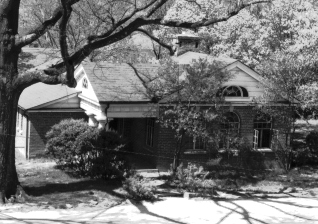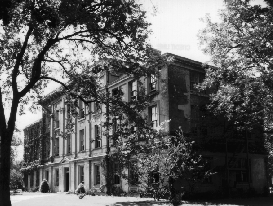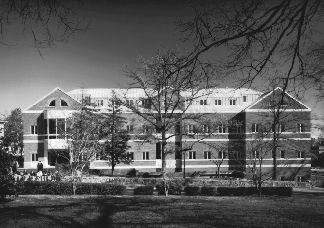
West House, the Department's home from 1964-1987. (Photo: Courtesy of the North Carolina Collection, UNC-Chapel Hill) |

New West Hall, the Department's home from 1969-1987. (Photo: Courtesy of the North Carolina Collection, UNC-Chapel Hill) |
For early research, IBM lent a model 2250 graphics engine, which on 22 April 1966 became operational in Phillips 265, a large classroom. The cooling fans made so much noise, however, that instructors complained, and Physics soon made room 273 available for the 2250. Thus was born the Graphics Lab, since renamed Graphics and Imaging Lab. By 1967, the Department staff had expanded into the remainder of West House and into some offices in Phillips basement, where the Computation Center occupied a former air-raid shelter. A few months into 1967-68, most of Phillips Annex was allocated to the Department, and the offices in Phillips basement were abandoned as all faculty moved into the Annex.
In summer 1969, we moved out of Phillips Annex into New West Hall, so named because it was much newer than Old West, which dated from the turn of the century (i.e. from the 18th century). Although we shared the fourth floor with the debating hall of the Dialectic and Philanthropic Societies, we quite reasonably considered New West to be our very own building. It served as our headquarters for 18 years. Technical challenges abounded in wiring for computers an edifice whose cornerstone had been laid in June 1859, but we did enjoy the sound insulation of the original interior walls of masonry. New West also brought us our own 54-seat classroom.
When we moved to New West, we partitioned West House into cubicles for computer-aided instruction. During 1969-70, the generosity of Physics (expressed through chairman Jim Crawford, who was ever cooperative and supportive) allocated to us the rear half of Phillips 271 for expansion of the growing Graphics Lab in room 273.
The Department continued to grow in students, faculty, and staff, and hence to need more and more laboratory space both for instruction and for research. We eventually expanded into most of the basement and first floor of Smith Hall, and into the entirety of Evergreen House. We even rented space in a commercial building on Rosemary Street, raising to six the number of premises occupied. Wiring all these premises for the expanding fleet of computing equipment was a major challenge, as was keeping the network and computers operational through nearby lightning strikes.
In 1983 the Microelectronics and Computer Technology Corporation (MCC) narrowed its site selection to two major candidates. After the Research Triangle Park lost to Austin, Texas, our governor Jim Hunt ascertained that one of the factors in MCC's decision was the perception that our state was not adequately supporting its leading computer science department. MCNC president Don Beilman was largely responsible for encouraging the governor to increase that support. Hunt was able to accelerate the budgeting process and we learned shortly that $9.2M had been appropriated for a new computer science building. We also received salary money for five more senior faculty members.
Realizing that we were unlikely to receive a further building in the ensuing half century, we thought long and hard about its design. We wanted the building to have a useful lifetime longer than the life to date of our discipline. That called for flexibility, so we opted for movable partitions and false floors, to permit space to be switched among different purposes. To make the partitions movable throughout, we accepted some large columns in return for having no interior load-bearing walls. Signal voltage levels in computers have fallen substantially over the years, but noise voltages have not. We therefore planned for voltages decreasing further during the life of the building and specified the building as a Faraday cage, with structural members connected to each other not only mechanically but also electrically, and thoroughly grounded. To make up for a severe lack of conference room space in our previous buildings, and to accommodate the proliferating research clusters, we sought a spatial layout emphasizing clusters and providing both closed and open conference areas. Finally, realizing that computers and communication were drawing closer together, we took an extra six months' delay to commission consultants to study our needs and recommend a plan for a state-of-the-art communication subsystem.
In February 1986, Arts & Sciences dean Gillian Cell (a history professor) proposed to Provost Sam Williamson (also a history professor) and Chancellor Chris Fordham that our new building be named for the distinguished retired history professor J. Carlyle Sitterson. He had served as chancellor during 1966-72, coincidentally an important period during the growth of the Department. UNC-CH traditionally names a building for each former chancellor, and the Board of Trustees soon approved. We named the teleclassroom for the late C. Hugh Holman (an English professor) and the main conference room for Lib Moore Jones, our founding secretary. We commissioned Bill Hipps to sculpt a bust of Fred Brooks for the Reading Room. The artist's fee was raised by contributions from Department friends and alumni.

Sitterson Hall, the Department's home from 1987 to the present. (Photo: © Rick Alexander)
Next Section: "Middle Childhood: 1974-78"